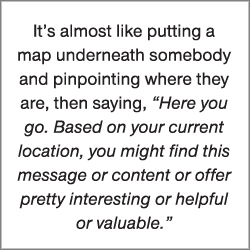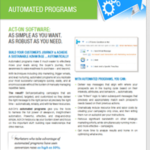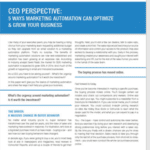Pure gold. That’s what automated email programs can be for marketers, empowering them to set up effective campaigns that run automatically, deliver the right message to the right person at the right time, and ultimately increase revenue and decrease effort.
Automated email programs are among the key features of a good marketing automation platform, providing a critical capability for businesses of all shapes and sizes. But many marketers – even those who use marketing automation – are unfamiliar with their value.
To help remedy this dilemma, I recently sat down with Aaron Bolshaw, Database Marketing Manager at Act-On, to shed light on the power of automated email programs. It’s been condensed for brevity.
There Had To Be a Better Way …
MONIQUE: Give me a brief history of how you discovered automated email programs.
AARON: Ok, I’m going answer that by stepping into the way-back machine. I’ve been doing email marketing for a dozen years. I started out at an in-house ad agency for Omaha Steaks and I ran their retail email program. (They had delicious steaks and, boy, did I get a great discount.) Anyway, then I moved to Mutual of Omaha and essentially did the same thing: email programs.
For both of those companies, it was a massive effort to launch an email. You needed to plan the message and the offer, you needed a copywriter, someone with web graphics chops, and process people to support the whole thing – list pulls, testing, sign-offs, et cetera.
So you’d blast it, right? Then you’d start over from square one … get the offer, get the promotion, get the copy written, get the graphics created, put it all together, get the list, create the landing page, test it all, then BLAST … and again, back to square one for the next one. It was a continual repetitive thing over and over and over again to get one email out.
When I took a position at HA Advantage, I knew email was going to be our huge marketing channel. But I wanted to do it a different way. So that’s when I made the switch to marketing automation and decided to execute with a start-up called Act-On.
MONIQUE: Wait a sec … you were an Act-On customer before you were an employee?
AARON: Yup. I believe I was Customer #16. And so all of a sudden, rather than having to do all this repetition and rely on a huge team of people to get an email campaign out the door, I was able to do all of those processes myself within the Act-On which was awesome. But then I learned I could also automate them.
MONIQUE: So it sounds like you kind of eased into the automated-programs piece after you adopted a holistic marketing automation solution. But I’m wondering why now … why automation was suddenly on your radar, particularly after you’d spent years doing email a different way, and a way that was normal at most companies?
AARON: Self-preservation. I knew I wanted to send messages out to different folks at different times, but I was pretty much the only guy in the marketing department. More custom messages to more specific audiences = working longer days and weekends. And frankly, Monique, as I thought about it, there was no good reason why email had to take so long. None.
Once I started using automated programs, I thought back and realized I was spending probably – and I’m not joking – about $750,000 per year of people’s time while I was at Mutual of Omaha. That wasn’t what the marketing program cost, that was just labor … just to do these emails.
MONIQUE: How many emails did you create and send for that kind of money? One per week? More?
AARON: [Laughter] Ha! No. More like 14 to 16 total in the entire year. You do the math.
MONIQUE: That’s roughly $50,000 per email.
AARON: In labor costs alone, yes. Crazy. But by automating my email programs, I was able to create all assets in a campaign, then hit the On button, sit back, and watch them go.
But it’s way more than just watching static messages fly out, because you can set up your programs to insert conditional messages … give your prospects time to open and click and engage with the content in order to determine what message to send next.
So you send out an email and then what you do is ask, “Well, did they open it? Did they click? Did they engage with the content? If so, how? And which pieces are they interested in?” So that the next message you send them can be customized based on their behavior with the previous messages … based on what you know they’re interested in and want to learn more about. It really brings content marketing to life.
And you can achieve this because of the conditional branching and conditional messages that you set up.
What is Conditional Branching?
MONIQUE: Explain “conditional branching.”
 AARON: Conditional branching allows you to add business logic to your process. Some know it as “if/then” logic. If some condition is met – such as downloaded a whitepaper on SEO, then do this specific thing next – such as send a follow-up email on SEO vs. SEM. If that condition isn’t met, then do this other thing.
AARON: Conditional branching allows you to add business logic to your process. Some know it as “if/then” logic. If some condition is met – such as downloaded a whitepaper on SEO, then do this specific thing next – such as send a follow-up email on SEO vs. SEM. If that condition isn’t met, then do this other thing.
So a conditional branch is like a pathway that you customize based on their behavior … their particular buying journey.
It’s almost like putting a map underneath somebody and pinpointing where they are, then saying, “Here you go. Based on your current location, you might find this message or content or offer pretty interesting or helpful or valuable.”
And all this is set up by automated programs. And after you set it up, you don’t have to lift a finger. You can strengthen relationships and definitely stay top-of-mind even if they don’t open your messages – because face it, people are insanely busy and don’t always open what anyone sends. But you’ve still incrementally created a brand impression just by being in their inbox.
MONIQUE: So if I’m hearing you correctly, you’re saying that automated email programs let you meet customers – or potential customers – where they are in their unique buying process or education process. What that says to me, then, is that you can use automated programs to identify where leads are in the sales funnel, yes?
AARON: Right. So let’s say your base list in the automated program has 10,000 records. And let’s further say you don’t even know where they are in their buying process – yet.
So as a marketer, you can start making segments … audience segments, customer segments, and behavior segments. And you can do it based on all kinds of things like, say, a lead score. You can decide that, for example, anyone with a lead score less than 20 is in the top of the funnel. If their score is between 20 and 40, they’re probably in the middle of the funnel, and a lead score over 40 is in an advanced stage – somewhere towards the bottom of the funnel.
Lead scoring is a whole topic on its own, and Act-On makes is super easy to do, but it doesn’t have to be lead scoring. You can create segments based on any combination of profile and behavior-based information. In Act-On you can create a segment really quickly, refresh it to activate it, and BAM … you know that out of the 10,000 records, 150 of them are really engaged RIGHT NOW. And you know that instantly.
So you can take that list of 150 and hand it over to sales. And then for the rest of the list, your automated program continues to run and tailor subsequent messages and the content you deliver based on where they’re at, who they are, what they’ve shown interest in.
Key Benefits of Automated Email Programs
MONIQUE: You’ve illustrated some fantastic capabilities that are probably just the tip of the iceberg. But can you give me, say, 3 to 5 reasons why a marketer should care about using automated programs?
AARON: Oh yea. First, time savings. With automated programs, you’re really putting something in place that is repeatable; it’s a marketing campaign that matches up against your revenue processes. And because it’s a repeatable process, it gives you the ability to start honing in and refining your campaigns and messages because you can start testing: “Does this message do better here or there? Does this change affect close rates and, if so, by how much?” Et cetera.
Second, more bandwidth to tackle more projects. Well, that’s kind of an extension of time savings, but more time means more ability to do more great things, right? Obviously you can – and will – do one-off messages because there’s always going to be a need for that … always. I mean, there’s great in-the-moment stuff that you should share with your prospects, but you wouldn’t create a long-term program out of it. But my point is that being able to communicate with a huge amount of different people who are at different places in their journey … and do it automatically and send them messages and offers right when your prospects want them … it’s fantastic.
Third, sales and marketing alignment. The number one thing most companies put in place first is a sales process – and that’s before ever thinking about hiring a marketer. So they get salespeople in place and they get going with similar things: they’re sending some emails out, and they’re following up with people who have engaged with the messages and content.
Of course, to generate demand and get more qualified leads in, companies need marketers. And automated programs let marketers say, “I can build a program that aligns right up to that sales process – perfectly dovetails it – and lets you take on more efficient and effective email prospecting in an automated fashion, and deliver the information right into your CRM system.
This is hugely beneficial because one supports the needs of the other. Marketers are able to give sales the hot leads that they normally would have to take a lot of time and effort to do themselves.
And so that leads to the fourth benefit which is increased revenue. Collectively, all these things I’ve discussed contribute to revenue, either through cost savings and higher actual sales.
And the fifth would be accuracy. What I mean by that is, once you set up a program and do the due diligence to test it and make sure it runs right, you can be secure in the knowledge that that email will always go out correctly. No more, “Oops, I sent the wrong email.” We’ve all done it, and we’ve also seen those apology emails, too. So it’s accuracy and making sure the right message goes out at the right time. Really.
Oh, and there’s a sixth one: customer intelligence. This goes to marketing automation in general, but automated email programs really help you turn a handful of initial data points – like someone’s name and email address, maybe their company and title – and turn that basic profile data into a behavioral profile as they engage with your messages and content.
The Act-On Difference
MONIQUE: Other marketing automation companies offer automated email programs, so why should someone choose Act-On?
AARON: There’s our simplicity and the ease-of-use, but specific to automated programs, ours are drag-and-drop simple to set up, and they include the ability to do conditional branching. Although some other companies also have drag-and-drop, many don’t offer conditional nothin’.
With Act-On, you can send, wait, and then take the temperature of each prospect to understand where they’re at and what they need next to continue down the sales funnel. Conditional branching lets you take everyone down a program like that, at huge scale. And we offer it at a price point no one can touch.
Also our easy integration with CRM systems that doesn’t require you to change your database. Most sales people live in their CRMs and use those tools as their database of record. A lot of competitor products require that they become your new database of record. Act-On doesn’t. So companies can keep using their CRM just like always, but the data is richer and the capabilities are vastly expanded with the integration with Act-On.
Bringing it Full Circle
MONIQUE: I’d like to come back to the beginning. You said you were sending maybe 16 campaigns per year before automation. How many do you send now?
AARON: Hundreds of emails across dozens of programs. Seriously, we have a lot of automated programs going all the time.
And Monique, I don’t lift a finger. They all just go, and they go exactly the way I want them to. Because of the way we’ve programmed them, contacts are all getting unique messages, they’re getting timely messages that match where they’re at in our sales cycle and – more importantly – where they are in their own journey to Purchaseville.
Here’s the thing: You don’t build relationships with emails. There is not an email in the world that can replace the value of calling someone and having a conversation. However, automated email programs really empower marketers to be better users of data without having to be programmers or trained analysts, and to more successfully craft the buyer’s journey. This means prospects get what they want when they want it, and sales can do what they do best: pick up the phone and have a relevant conversation, provide value, and close more sales.
Learn More
Interested in getting started with automated programs, or want to learn a bit more? The following resources will help you out.
 |
 |
 |
| Automated Programs Datasheet |
The Business Case for Marketing Automation |
CEO Perspective: 5 Ways Marketing Automation Can Grow Your Business |
